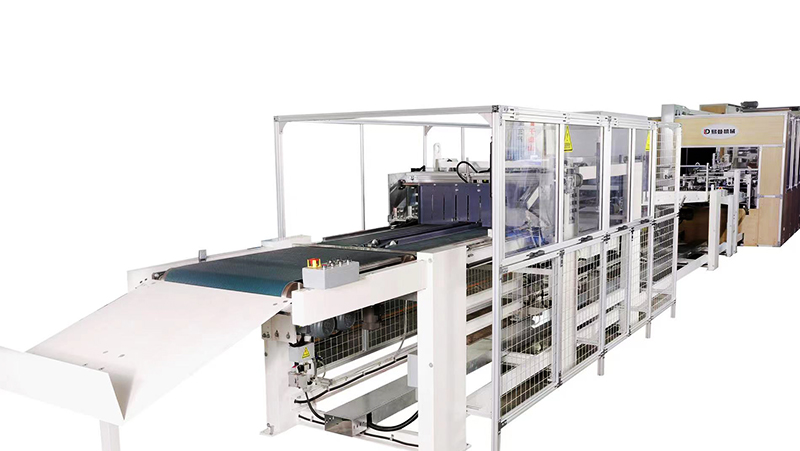Revolutionizing Sustainable Packaging: The RFID-Integrated Paper Bag System
Release time:2025-05-15 Classification:Knowledge
In an era where sustainability intersects with technological innovation, the RFID-integrated paper bag system emerges as a transformative solution for modern packaging and logistics. Combining the eco-friendly benefits of paper-based materials with the precision of Radio-Frequency Identification (RFID) technology, this system addresses critical challenges in supply chain management, inventory tracking, and consumer engagement. This article explores the design, functionality, and applications of RFID-integrated paper bags, highlighting their role in advancing both environmental goals and operational efficiency.

1. The Architecture of RFID-Integrated Paper Bags
At its core, the RFID-integrated paper bag system embeds ultra-thin RFID tags into the structure of recyclable paper bags. These tags are strategically placed during manufacturing to ensure durability without compromising the bag’s integrity. The RFID component typically includes a microchip and antenna, which store and transmit data wirelessly when activated by an RFID reader. Unlike traditional barcodes, RFID tags require no line-of-sight scanning, enabling rapid, bulk identification of items—even when concealed within the bag.
The paper material is selected for its strength, recyclability, and compatibility with RFID signals. Advanced adhesives and laminating techniques ensure the tag remains functional throughout the bag’s lifecycle, including exposure to moisture, temperature variations, and physical stress.
2. Operational Advantages in Supply Chain Management
The integration of RFID technology into paper bags unlocks unparalleled efficiency in logistics and inventory control. Key benefits include:
- Real-Time Tracking: RFID-enabled paper bags allow stakeholders to monitor the movement of goods from production facilities to end-users. Each bag’s unique identifier enables granular tracking, reducing errors in shipment routing and delivery.
- Automated Inventory Audits: Warehouses and retail environments leverage RFID readers to perform instant inventory counts, eliminating manual scanning and minimizing labor costs.
- Anti-Counterfeiting Measures: By embedding encrypted data within tags, the system enhances product authenticity verification, a critical feature for industries like pharmaceuticals and luxury goods.
- Waste Reduction: The reusability of RFID-integrated paper bags, coupled with their recyclable nature, supports circular economy initiatives by minimizing single-use packaging waste.
3. Consumer-Centric Applications
Beyond logistics, RFID-integrated paper bags enhance user experiences through smart functionalities:
- Personalized Marketing: Retailers can embed product information, promotions, or loyalty program details in RFID tags. Shoppers access this data via smartphone apps or in-store kiosks, fostering engagement.
- Returns and Recycling Incentives: Consumers can quickly scan bags for easy returns or recycling instructions. Some systems even reward users for returning bags to designated collection points.
- Enhanced Security: In high-theft environments, RFID tags trigger alerts if unpaid items pass through exit zones, bolstering loss prevention efforts.
4. Sustainability Synergy
The environmental benefits of paper bags are amplified by RFID integration. Unlike plastic alternatives, paper decomposes naturally, reducing landfill burden. RFID tags, when designed with eco-friendly materials, further align with sustainability goals. Additionally, the system’s ability to optimize supply chain routes reduces carbon emissions by minimizing redundant transportation.
5. Challenges and Future Directions
While promising, the widespread adoption of RFID-integrated paper bags faces hurdles:
- Cost Considerations: High-frequency RFID tags and specialized readers require upfront investment, though prices are declining as adoption scales.
- Standardization: Industry-wide protocols for tag placement, data formats, and encryption are needed to ensure interoperability.
- Consumer Education: Users must understand how to interact with RFID-enabled packaging to maximize its benefits.
Future advancements may include biodegradable RFID tags, energy-harvesting designs, and integration with IoT platforms for end-to-end supply chain visibility. Researchers are also exploring AI-driven analytics to derive actionable insights from RFID-generated data.
The RFID-integrated paper bag system represents a paradigm shift in sustainable packaging, merging ecological responsibility with cutting-edge technology. By enhancing traceability, reducing waste, and enriching user interactions, this innovation positions itself as a cornerstone of smart, green logistics. As industries and consumers increasingly prioritize sustainability, RFID-equipped paper bags are poised to become a standard in global supply chains, driving efficiency while safeguarding the planet.






